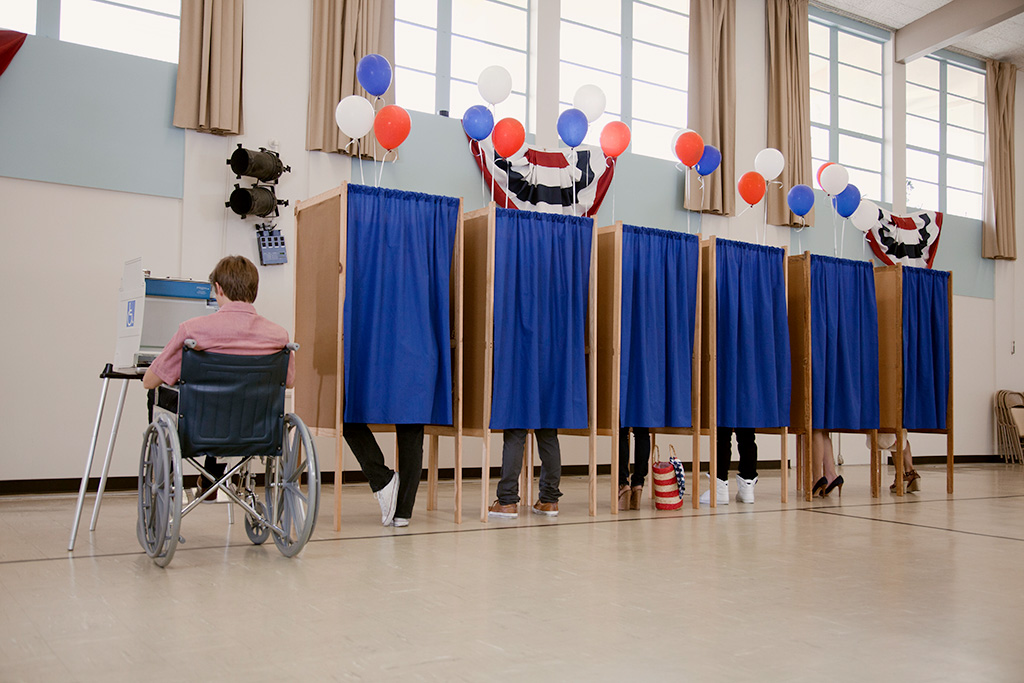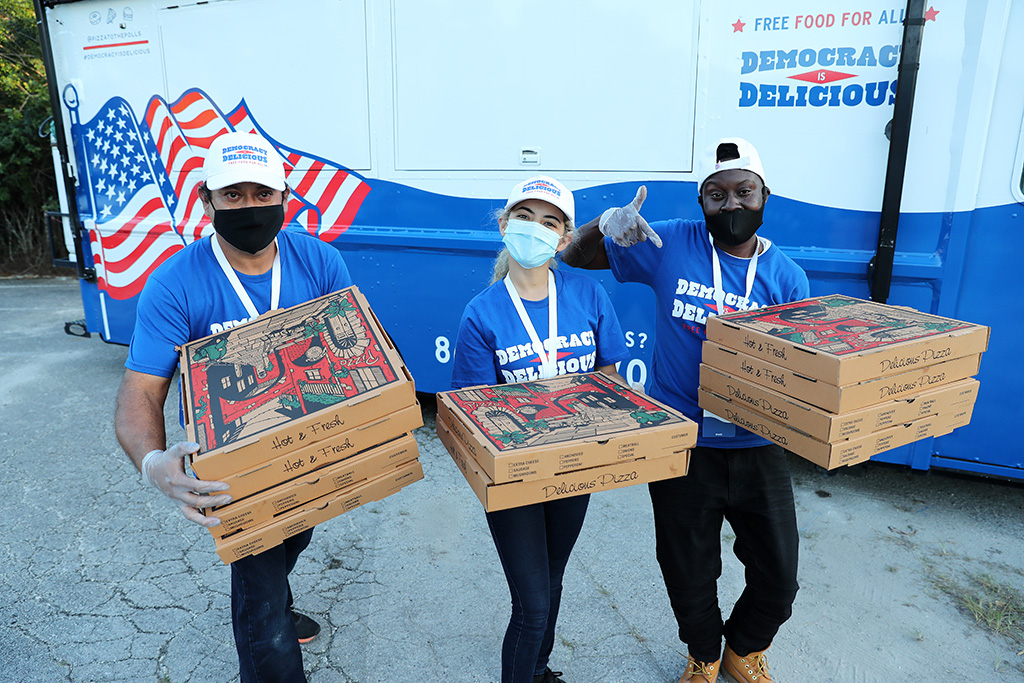Martin Luther King Jr. Day has been observed annually as a federal holiday on the third Monday of January since 1983, 15 years after the luminary’s death. It’s a day on, not off: a day to offer our time in service to those around us. To honor the civil rights leader this year, we’re looking at the ways people have supported civil rights in their own communities—namely, by helping mobilize voters.
Read on for three stories of people who have found creative ways to encourage and support voters in recent years—and to learn how you can help, too.
A Slice for Democracy
Ilir Sela knows the sweat that goes into keeping a restaurant afloat—he comes from a family with three generations of pizzeria owners. He’s witnessed firsthand the struggles of operating an eatery through changes in technology and rising competition from pizza chains.
That’s why, in 2010, Sela created Slice to support independent and local pizzerias—including small and regional franchises—by providing affordable access to modern tools like online ordering, marketing, analytics and even supplies like bags and boxes. Today, Slice partners with more than 18,000 pizzerias across 3,000 cities in all 50 states and has become the nation’s largest community of independent and local pizzerias.
His mission was simple: to keep local slice shops thriving.
“I started Slice to help local pizzerias like my family’s keep pace with the digitization of the world around them and ensure that they remain at the heart of our communities, like other small businesses,” Sela says by email.
In recent years, Slice has begun helping voters, too. Ahead of the 2020 presidential election, Slice partnered with Pizza to the Polls, a nonprofit that works with local pizzerias to deliver savory pies to hungry poll workers and voters waiting in long lines to cast their ballot.
Slice works with Pizza to the Polls to fulfill pizza orders through Slice’s platform. Anyone from the public can make a donation to Pizza to the Polls, and those funds are used to buy the pizza from independent or local pie shops.
Ultimately, this benefits both the pizzerias and the voters with empty stomachs. In recent years, Sela says he’s heard reports of voters waiting 10 to 15 hours to cast their ballot—sometimes longer. The success of this partnership—which has resulted in more than 400,000 pizza slices being delivered to people waiting in polling or vaccination lines (more on that later) since the partnership began—shows just one slice of how community members looking out for each other can encourage civil rights.
“Even if you are not directly involved with the democratic process, your donation has provided sustenance to the people standing in line and brought attention to an independent business,” Sela says.
Slice has also partnered with Pizza to the Polls on adjacent initiatives, such as Vax and Snacks, which provides pizza to people waiting in lines to be vaccinated against COVID-19. They also collaborated on 2020’s Pizza vs. Pandemic project, which fed frontline workers across all 50 states.
“We’re always looking at ways we can use the power of local pizza to support communities and the local businesses in them,” Sela says.
Get involved like Ilir
Order local. Give back to the platform and pizzerias that are supporting poll workers and voters during major elections. Next time you’re craving a pie, check out local offerings on the Slice website. And on the next Election Day, if you see a queue at a polling place, consider using Pizza to the Polls to send over a couple of pies.

Breaking Down Barriers
In 2016, while working on Hillary Clinton’s presidential campaign team as a coordinator for a disability policy working group, Dylan Bulkeley came up with an idea to bring more parity to the election process.
The campaign placed an emphasis on people with disabilities, and Bulkeley, who has dyslexia, felt a particular connection to this effort. Inspired, he began working to better understand the pain points for voters with disabilities. Then he used this background to build The Brink Election Guide, a nonpartisan, nonprofit app that rounds up voting resources in an accessible way to make it easier for voters with disabilities to cast their ballot.
“My experience as the coordinator really led to me realizing that the voter engagement and turning out the vote is kind of the most important part no matter what,” Bulkeley says.
Historically, people with disabilities have encountered obstacles that can keep them from casting their ballot. In 2020, 11% of people with disabilities had trouble voting. In the past, that number has been higher—in 2012, for instance, 26% reported trouble voting, according to a 2021 report from Rutgers University. Overall, these voters are nearly twice as likely as voters without disabilities to report challenges casting their ballots.
“We needed to make sure the disability community was turning out,” he says. “I wanted to focus on get out the vote, on voter mobilization.”
Bulkeley’s app helps break down some of these barriers, though he’ll be the first to tell you that he’s not reinventing the wheel. The app essentially provides a roundup of various election information that people would otherwise have to search for on disparate websites. Users can check voting deadlines, see whether they have early voting in their state, check their voter registration and research candidates. Importantly, the app is designed to be accessible to more people. It can be used with a screen reader, for instance, and is available in Spanish and English. Bulkeley said he hopes to add more languages in future years.
The decision to have an app over a website was also made with accessibility in mind. People with disabilities are more likely to have limited opportunities to earn income, due to salary caps required to receive healthcare and job options that aren’t accessible, among other things. Because of this, not all people have the money to afford an at-home computer. It’s more likely that someone could afford a cell phone.
Another benefit of an app is that people can us it while at polling locations. So not only can they reference the information while voting, but they can use Brink’s reporting feature to relay that a certain polling location lacks accessibility features or that they experienced voter intimidation.
“If you’re going to get there and be questioned about your capacity to vote or not even be able to get into the building … that’s incredibly frustrating, and you can see why it leads to a gap [in voter turnout],” he said.
Though Brink is designed for people with disabilities, the app can benefit anyone. This is a reflection of the principle of universal design—or the idea that making products accessible to all people can benefit everyone—in action.
For instance, one year Bulkeley learned that multiple people waiting in line to cast their ballot found its format useful. They could research candidates and learn more about their voting options all in a single place on their phone. Soon, many people in the voting line were downloading the app.
“Once things are built to be accessible for the disability community, everyone benefits,” he says.
Get involved like Dylan
Spread the word. Prepare for the next election by checking out the app. If it works for you, tell your friends about it so they can benefit, too. Note: The app remains dormant between elections.
Get creative. You don’t have to engineer an app to make a difference. There are many ways to help would-be voters get to the polls. Maybe you offer a friend without a car a ride to the polls. Or you offer to pick up a colleague’s shift, so they can make time to send in their ballot. Everything counts.

Volunteering for the Vote
What pairs well with a large cheese pizza? Some would say democracy.
Erin Haglund has volunteered with Pizza to the Polls for six years. On Election Day, she stations herself at a computer, gathers orders using the nonprofit’s dashboard, verifies that the polling place exists and places the pizza delivery with a local shop.
It’s a win-win: People in long polling lines get a warm slice of pizza while they wait; independent pizzerias get business.
“Standing in line is the worst, but this takes something that is not the most pleasant and gets people excited,” Haglund says. “Who doesn’t love free stuff? And that the free stuff is pizza is even better.”
Haglund first came across Pizza to the Polls while perusing social media. She wanted to find a volunteer opportunity, but wasn’t interested in door knocking and, though she’d sent postcards and texts to voters in the past, she wanted to directly help people in line at polling locations. Pizza to the Polls offered just that.
“I really love pizza and I really love voting, so this was like the most perfect intersection of two of my interests,” Haglund says.
Pizza to the Polls formed during the 2016 election. Long lines across the country prompted founders Scott Duncombe, Noah Manger and Katie Harlow to look for a way to support the people waiting to cast their ballots. Their idea: Send savory slices of pizza to voters and poll workers. During that election, they raised money online—about $10,000—and coordinated the delivery of more than 2,000 pizzas to more than 100 polling places spanning 24 states.
The momentum of that first election has carried into future years. In 2020, the nonprofit delivered about 65,000 pizzas to more than 3,000 polling locations across 48 states. In 2022, they delivered more than 75,000 snacks using food trucks and delivery services in addition to more than 4,500 pizzas, most of which came from independent pie shops. To receive one, voters simply have to call in and report a line at a polling location. Volunteers like Haglund then verify that the polling location exists and place the order with a local pie shop.
Because the work is nonpartisan, anyone can feel comfortable volunteering, reporting a long line and receiving a slice. For Haglund, this was an important aspect of the effort.
“I wanted to do nonpartisan, get-out-the-vote work because I think it’s such an important part of being American,” Haglund says. “It can seem difficult or inconvenient, so I wanted to see what I could do to make it easier.”
Making a difference, it turns out, can be as simple as offering a slice of cheesy, savory goodness.
“When you can anticipate that hot food is coming your way, it makes the day a little brighter.”
Get involved like Erin
Volunteer. Help fill pizza orders. The best part: You can do this remotely. If you’re interested in learning more, you can send an email to morequestions@polls.pizza.
Report a line. Are you waiting in a long queue at a polling location? Spot one while walking your dog? Report it to Pizza to the Polls, so the team can send over a hot meal.


